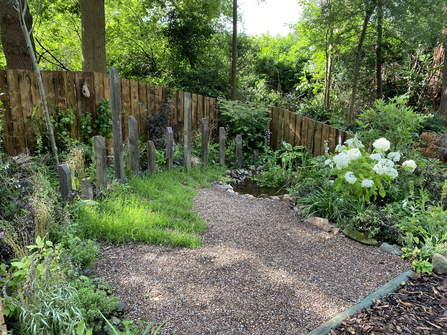
How to make a log shelter
Log piles are perfect hiding places for insects, providing a convenient buffet for frog, birds, and hedgehogs too!
Putting together a log pile will create a village for all things creepy and crawly. In turn, this busy community will attract birds, hedgehogs and frogs looking to snack on a tasty morsel. Perhaps the most spectacular garden deadwood denizen is the 50 mm-long stag beetle, which is found in light soils south of a line from the Wash to Bristol. Stag beetle larva stays in old wood for up to six years before emerging as an adult, ready to mate!
You will need
- Logs! You can get them from tree surgeons or firewood dealers. If you’re lucky, some pieces may already contain beetle grubs which could hatch and populate your garden. Native wood is best, but anything will do.
Building your log shelter
You can build up the logs to form your ‘minibeast village’ in a variety of ways:
- Scattered: Scatter your logs in a flower border or under a hedge. Like this, they are handy for keeping plants apart and mulching the soil, but you’ll get more wildlife if you do create a concentrated stack.
- Neat and tidy pile: Tidy stacks are often seen in coppiced woodlands. Logs are carefully piled on top of each other, often forming a pyramid.
- Higgledy-piggledy: The ‘natural’ way to do it, and great for architectural impact. But it doesn’t create much shade.
- Organ pipes: Sunken wood creates the most micro-climate possibilities. Especially recommended in the Thames Valley for stag beetles. If you can’t bury your logs, heaped wood chippings are another way to help stag beetles.
- Giant cheese: If you can get a real ‘wagon wheel’ log, it will create the most stable environment of all underneath. Superb for amphibian hibernation.
This busy community will attract birds, hedgehogs and frogs looking to snack on a tasty morsel
The five stars of the show...
- Devil's coach horse: Ferocious, predatory beetle that curls its tail up in defence – even at humans! Great for the garden, it eats invertebrates and pests like vine weevil. It can deliver a painful nip, however, so handle with care!
- Brown centipede: Up close, its honey-brown, segmented body hosts just 15 pairs of legs, despite its name! This predatory invertebrate has poisonous claws and large, biting jaws to catch its prey, but is harmless to humans. It may live for four years.
- Lesser stag beetle: Smaller than its famous cousin, it often arrives hidden in firewood logs as a large grub. Save any logs with signs of holes or rot, and adults may emerge in June.
- Common toad: This amphibian may live for up to 10 years if you provide a friendly garden and hefty log pile for it to hibernate in. Likes sparser ponds than frogs and newts.
- Common woodlouse: A familiar minibeast, it is an important recycler of nutrients, feeding on decaying matter. It also provides prey for birds and the specialised woodlouse spider, whose jaws can even pierce human skin!
Other ways to help insects!

Create a wildlife garden!
Discover our Parkridge Centre inspiration garden and find out how you could add:
-
a wildlife pond
-
solitary bee posts
-
climbing plants
-
hedgehog holes



